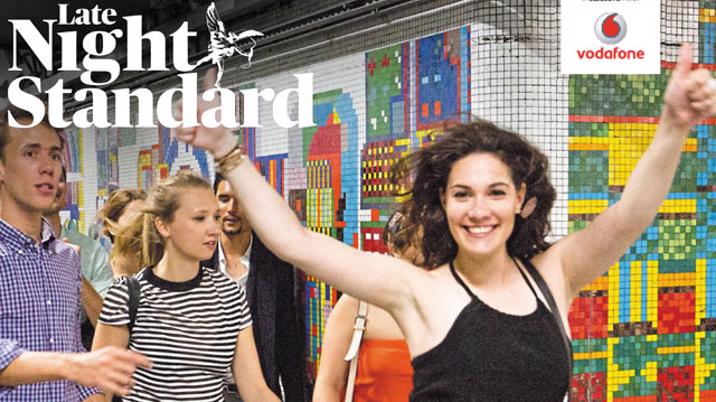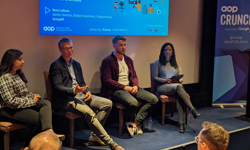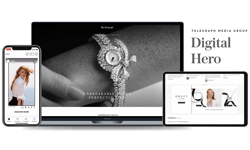
It did not take long for ESI Media to come up with a name for its new one stop shop creative agency. Story Studio was an obvious choice for a team which brings together the editorial and commercial expertise of the publisher of the London Evening Standard, ES Magazine and The Independent to create bespoke branded content for clients across print and digital. “The idea of it being a place where you create great stories was pretty clear,” explains Jon O’Donnell, managing director of ESI Commercial.
The team of around 28 comprises content editors and creators, project managers and designers working across print and digital. It is led by Charlie Edelman, director of story studio and includes Kate Barlow, head of commercial content, Ben Bibbings, head of project management, Michelle Gregory, head of communications and Nenad Bogojevic, head of design, as well as drawing on editorial talent such as the writer and broadcaster Grace Dent and Ellen E Jones, formerly The Independent’s TV critic.
Story Studio taps in to the increasing trend for publishers to set up dedicated teams to produce branded content and native advertising, such as The Foundry at Time Inc and Imagine by Immediate Media.
O’Donnell believes: “For quite some time, clients have been looking for much deeper partnerships that get you a closer relationship with the audience. There’s no better way of doing that than creating a relationship through content.” He adds that sponsored content can work particularly well when a client has a specific set of goals. “It could be anything from increasing brand awareness, to launches, increasing footfall or an event; consumers need a slightly different conversation.”
Editorial base
The team sits on ESI Media’s editorial floor rather than on the commercial floor. “It’s important that Story Studio is linked very closely to the editorial team,” O’Donnell insists. He adds: “We have a group of journalists in key verticals such as film, food and technology, who write for us editorially but have a portion of time that’s carved out for commercial work. That can be anything from coming up with ideas for clients, to writing content. The key is when they come to talk to a client about a brief, we believe they are going to be closer to that client industry. If you have someone who’s writing about food one day and fashion the next, that makes it difficult for them to fully understand that industry. This is not about blurring lines between editorial and commercial, it’s about understanding what language they need to use.”
What happens if a journalist has to write a news story or editorial piece about a client they have worked for on sponsored content? O’Donnell is quite clear: “It’s absolutely imperative that they remain impartial and have the ability to write what they want about anybody. The reason clients work with us is because we have that level of authenticity.”
O’Donnell believes that ESI Media’s portfolio of brands appeals to clients who want to target a South East audience and a national and international audience that is open to new ideas: “We have a fantastic London powerhouse in the Evening Standard brands across print, digital and TV. The Independent is a national proposition and has a very strong footprint in the US. We are really starting to see clients understand what The Independent website is about. If you’re looking to challenge the status quo, you’re going to resonate with this audience.” Story Studio clients also have access to ESI Media’s sister company, the TV channel London Live.
The process
So how does the creative process work? Charlie Edelman explains: “When a client gets officially handed over from the sales team to Story Studio, we would talk to them in depth at a kick-off meeting and then we’d have some ideas up front and develop our thinking. What’s really important is to understand what a client’s objectives are. Is it possible to meet them and what can we do to meet them and get above and beyond? The other thing is to be really flexible in our approach.”
She cites the example of the Evening Standard’s partnership with Vodafone to bring out a special ‘Late Night Standard’ edition to tie in with the launch of the 24-hour Night Tube. Vodafone was the sole commercial partner for the one-off late edition, which was distributed between 5.30pm and 11.30pm on the first evening the Night Tube started running. The one-off edition contained a mixture of native and branded content focusing on late night London to align the brand with a big moment for the capital and build on the messaging that Vodafone ‘empowers people to feel free to live life their way’. The brand’s aim was to create disruption, drive awareness that it had put an end to line rental charges and to take market share from competitors in a crowded marketplace. “They didn’t have a comms plan for that piece because we suggested it to them,” reveals Edelman. “So, we had to be much more flexible. You need processes and to try to stick with those when you are managing 40 or 50 projects at a time. But at the same time, you need to know when to step outside of those. We want it to be the best.” Of those readers surveyed on the night, 95% loved the concept, 67% said the content appealed to people like them and 52% of those with broadband accounts said they would consider Vodafone next time.
Another stand-out campaign for Story Studio was its ‘Watchers on the Wall’ collaboration with Sky Box Sets to promote the earlier series of Game of Thrones, ahead of the airing of Season 6. “They wanted to start a conversation, but when you’ve got a longstanding series, it’s quite difficult. So, we came up with the idea of a couple of social media competitions - ‘How would you get your friends to #jointhewatch?’ and ‘Share your favourite moment for the chance to win’. That created fantastic rich content from users which we could then put into print.” In addition, a weekly double page spread in the Evening Standard featured articles from a first-time watcher and from long-time fan Grace Dent, while a section in ES Magazine discussed a different series of the show each week with selected fans from around the capital. The five-week campaign achieved over 110,000 page views for its hub page; promotion of the social media competitions led to 3,684 entries and 670,233 social media impressions; in print, the campaign reached more than 5 million adults and among Evening Standard readers, 5% of non-Sky subscribers who saw the campaign subscribed to Sky as a result of the advertising. “Ultimately, it’s about making the creative work as hard as possible in terms of the client’s brief,” enthuses Edelman.
Digitally driven
There is no doubt that the shift to digital media is behind the rise of branded content. Edelman believes: “What digital allows you to do is extra things or different things. You can test a lot more digitally. It’s much easier to create interactive engagement online. For example, for Maille [the French mustard brand], we took a very traditional approach in ES Magazine and created a Flavour Creators Map to promote their Fête de la Gastronomie, trying to get people to the event, and I wouldn’t denigrate that approach. What we did online was allowed it to become interactive, with pop ups and a poll so people could vote for which of the dishes they’d like to try. That increases the dwell time but also gives people a way to interact with that brand.”
Story Studio recently won the Newsworks 2016 award for Best Content Partnership for the work it did for fashion retail outlet chain McArthur Glen around London Fashion Week. Each day, the fashion team at ESI Media identified a different catwalk trend which they then married up with products available at McArthur Glen centres to create digital ‘cascade’ videos, leading to 50 social media posts over the course of fashion week. Traffic was driven to bespoke hubs on independent.co.uk and standard.co.uk featuring all of the Fashion Week content along with more details about McArthur Glen’s brand offering. “We commissioned filming at Fashion Week. That film would be edited overnight and come in in the morning. We had the McArthur Glen look book and it was about being able to make a connection that was believable and true. It all had to be done incredibly quickly, so we created a lot of templates up front and ran through a couple of different scenarios,” says Edelman. She adds: “I believe there is no reason why branded content should not read as well as editorial. I think that we have a really collaborative approach with our editorial team. We believe passionately in editorial integrity and being prepared to innovate digitally rather than just saying ‘this is the package, this is what we do’.
O’Donnell agrees that whether you are talking about branded content or pure editorial, what today’s audience cares about is the quality. “The key thing is not trying to be all things to all people. It’s about what will make the idea sing. We are always looking at different ideas, different platforms and how we could use them with our brands. What the audience don’t want is poorly thought through content. They want things that work. We did some research talking to millennials about commercial content. They know the difference. They want content that is going to add something, they don’t care whether it is commercial or not.”












